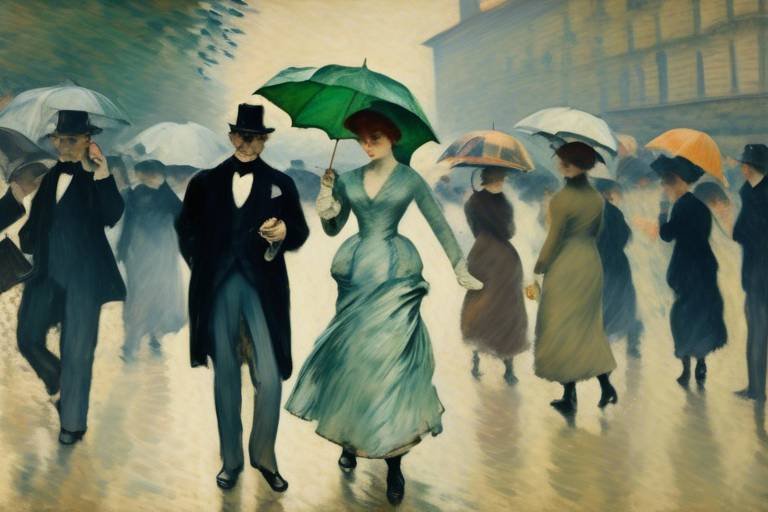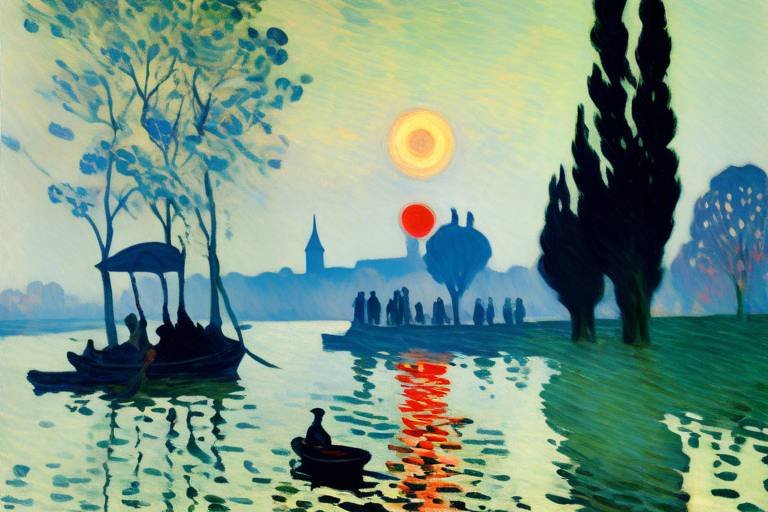The Aesthetics of Landscape Painting in Different Cultures
When it comes to landscape painting, the diverse interpretations across different cultures offer a fascinating insight into how societies perceive and portray nature through art. Each culture brings its unique artistic styles, influences, and perspectives to the canvas, creating a rich tapestry of landscapes that reflect both the physical world and the cultural imagination.
In Chinese landscape painting, tradition and philosophy play a significant role in shaping the artistic expression of nature. The emphasis on harmony, balance, and symbolism in traditional Chinese art results in landscapes that are not merely visual representations but also convey deeper philosophical meanings. Techniques such as ink wash painting and the use of empty space to evoke a sense of vastness are characteristic of Chinese landscape painting.
On the other hand, European landscape painting has undergone a fascinating evolution over the centuries. From the romanticized depictions of the natural world in the Romantic era to the realistic landscapes of the Impressionists, European artists have explored a wide range of styles and approaches to capturing the beauty of the land. Each movement, from Baroque to Realism, has left its mark on the portrayal of landscapes in European art.
Japanese landscape painting offers a unique perspective on nature, focusing on simplicity, harmony, and a deep spiritual connection to the natural world. Sumi-e, the traditional Japanese ink wash painting, emphasizes the beauty of nature through minimalistic brushwork and a profound appreciation for the fleeting moments of natural beauty. Japanese landscapes often evoke a sense of tranquility and contemplation.
Indigenous cultures around the world have their own landscape art traditions that reflect their deep spiritual connection to the land. Through vibrant colors, intricate patterns, and symbolic imagery, indigenous artists convey their cultural heritage and intimate relationship with the natural environment. These artworks serve as a testament to the enduring bond between indigenous peoples and the landscapes they inhabit.
In the realm of modern interpretations of landscape painting, artists have pushed the boundaries of traditional aesthetics, experimenting with abstract forms, surreal imagery, and unconventional materials. These contemporary approaches challenge conventional notions of landscape art, inviting viewers to reconsider their perceptions of nature and the environment.
Symbolism plays a crucial role in the interpretation of landscapes across cultures, with each element in a painting carrying meaning beyond its visual representation. Whether it's the use of specific colors to evoke emotions, the inclusion of symbolic motifs to convey spiritual beliefs, or the arrangement of elements to reflect cultural values, landscapes in art are laden with layers of significance waiting to be deciphered.
Exploring the techniques and materials used in landscape painting reveals a world of creativity and innovation. From the delicate brushwork of traditional watercolor to the bold strokes of acrylics and the experimental use of mixed media, artists employ a wide range of tools and techniques to bring landscapes to life on canvas. The choice of materials often influences the texture, color, and overall aesthetic of the artwork, adding another dimension to the artistic process.
The impact of landscape painting on society goes beyond aesthetics, influencing how people perceive and interact with the natural world. By portraying landscapes in art, artists raise awareness about environmental issues, instill a sense of appreciation for the beauty of nature, and inspire viewers to become stewards of the earth. Through their creations, artists have the power to shape societal attitudes towards nature and promote environmental consciousness.

Chinese Landscape Painting
Chinese landscape painting is a rich artistic tradition that dates back thousands of years, characterized by its unique techniques and deep philosophical influences. In traditional Chinese art, landscapes are not merely representations of the physical world but serve as expressions of the artist's inner thoughts, emotions, and spiritual connections to nature. The emphasis is not on realistic depiction but on capturing the essence and mood of a landscape through symbolic brushwork and composition.
One of the key principles in Chinese landscape painting is the concept of "qi yun sheng dong," which translates to "spirit resonance and life movement." This idea emphasizes the dynamic energy and vitality of nature, with artists seeking to convey the rhythm and flow of natural elements such as mountains, rivers, and trees. By using techniques like "shan shui" (mountain-water) painting, Chinese artists create harmonious compositions that balance the contrasting forces of yin and yang.
Symbolism plays a significant role in Chinese landscape painting, with elements like rocks, trees, and water symbolizing philosophical concepts such as strength, resilience, and the cyclical nature of life. The use of empty space, known as "wu wei," is also crucial, allowing viewers to engage their imagination and contemplate the deeper meanings within the artwork.
Moreover, the materials and tools used in Chinese landscape painting are carefully selected to enhance the artistic expression. Traditional Chinese ink, made from soot and animal glue, is applied with various types of brushes to create diverse textures and effects. Rice paper, known for its absorbency and delicate texture, is often used as the painting surface, allowing for subtle gradations of ink and washes.
Overall, Chinese landscape painting embodies a profound reverence for nature and a spiritual connection to the world, inviting viewers to contemplate the beauty and harmony of the natural environment through the eyes of the artist.

European Landscape Painting
European landscape painting has a rich history that spans centuries, evolving through various artistic movements and styles. From the romanticized depictions of nature in the Romantic period to the more realistic approach of the Impressionists, European artists have captured the essence of landscapes in diverse ways. Influenced by the changing socio-political landscapes of Europe, these paintings often reflect the artists' perspectives on nature, society, and the human experience.
In the early days of European landscape painting, artists often used landscapes as a backdrop for religious or mythological scenes. However, as the Renaissance period unfolded, there was a shift towards depicting landscapes as subjects in their own right, with artists like Leonardo da Vinci and Albrecht Dürer exploring the beauty of nature in intricate detail. The Dutch Golden Age also saw a surge in landscape painting, with artists like Rembrandt and Vermeer capturing the serene countryside and bustling cityscapes.
During the Romantic period, European landscape painting took on a more emotional and expressive tone, with artists like J.M.W. Turner and Caspar David Friedrich conveying the sublime power of nature. These paintings often featured dramatic skies, rugged terrains, and mystical elements, evoking a sense of awe and wonder in the viewers. The Impressionists, on the other hand, focused on capturing the fleeting effects of light and atmosphere in their landscapes, using loose brushwork and vibrant colors to create a sense of movement and immediacy.
As European art continued to evolve, artists like Vincent van Gogh and Claude Monet pushed the boundaries of traditional landscape painting, experimenting with new techniques and perspectives. Van Gogh's swirling skies and vibrant colors conveyed his emotional turmoil, while Monet's series of water lilies captured the ever-changing beauty of nature. The European landscape painting tradition continues to inspire artists around the world, with contemporary painters exploring new ways to interpret and represent the natural world.

Japanese Landscape Painting
Japanese landscape painting, known as Sumi-e, holds a unique place in the world of art with its emphasis on simplicity, harmony, and spirituality. This traditional Japanese art form focuses on capturing the essence of nature rather than detailed realism. Artists use black ink and water to create monochrome paintings that convey the beauty of landscapes with minimalistic brushstrokes.
The philosophy behind Japanese landscape painting is deeply rooted in Zen Buddhism, aiming to reflect the interconnectedness between humans and nature. By embracing imperfections and asymmetry, Sumi-e artists seek to evoke emotions and provoke contemplation in viewers. The art form values the empty spaces within the composition as much as the inked areas, symbolizing the importance of silence and tranquility.
Japanese landscape paintings often feature elements such as mountains, rivers, trees, and clouds, symbolizing harmony and balance in nature. The use of negative space in Sumi-e is crucial, allowing viewers to engage in a dialogue with the artwork and interpret the meaning based on their own experiences and emotions.

Indigenous Landscape Art
Indigenous landscape art offers a profound insight into the deep spiritual connection that various indigenous cultures worldwide hold with their land. These artworks go beyond mere visual representation, embodying a sacred relationship with the natural world. Indigenous artists often infuse their landscapes with symbolic elements that reflect their cultural beliefs and ancestral wisdom. Through intricate patterns, colors, and motifs, they convey stories of creation, survival, and the interconnectedness of all living beings.
One striking feature of indigenous landscape art is the emphasis on portraying the land as a living entity, pulsating with energy and history. The landscapes are not just physical representations but embodiments of spiritual beings and ancestral presence. This holistic approach to nature reflects a worldview where humans are seen as integral parts of the environment, rather than separate entities dominating it.
Moreover, indigenous landscape art often serves as a form of cultural preservation, keeping alive ancient traditions and knowledge passed down through generations. The intricate details in these artworks carry layers of meaning, inviting viewers to delve into the rich tapestry of indigenous cosmologies and belief systems.
Through their art, indigenous communities express their resilience, resistance, and reverence for the natural world. The landscapes they create are not merely scenes to behold but gateways to understanding the profound connections between humans, nature, and the spiritual realm. Each brushstroke, each color choice, and each symbol in indigenous landscape art tells a story of survival, adaptation, and the enduring bond between people and their land.

Modern Interpretations
Modern interpretations of landscape painting have pushed the boundaries of traditional artistic norms, ushering in a new era of creativity and experimentation. Artists today are exploring innovative styles that challenge conventional ideas of what a landscape should look like. From abstract representations that evoke emotions and sensations rather than depict reality to surreal landscapes that blur the line between dream and reality, modern interpretations offer a fresh perspective on the natural world.
One prominent trend in contemporary landscape painting is the use of experimental techniques and unconventional materials. Artists are combining traditional brushwork with digital technology, creating mixed media pieces that incorporate elements of photography, collage, and even sculpture. These diverse approaches not only showcase the artist's technical skill but also invite viewers to reconsider their preconceived notions of what constitutes a landscape painting.
Furthermore, modern interpretations of landscapes often delve into the realm of environmental consciousness and social commentary. Artists are using their work to highlight pressing issues such as climate change, deforestation, and urbanization. Through their art, they aim to provoke thought, spark dialogue, and inspire action towards a more sustainable relationship with the natural world.

Symbolism and Meaning
Symbolism and meaning play a significant role in the interpretation of landscapes in art across various cultures. In Chinese landscape painting, the use of specific elements like mountains, water, and trees symbolizes harmony, balance, and the eternal cycle of life. These natural elements are often imbued with deeper philosophical meanings, reflecting the interconnectedness of humanity and nature.
In European landscape painting, the symbolism often revolves around romantic ideals of nature, with scenes depicting sublime beauty, tranquility, or even the sublime power of nature. Artists like Caspar David Friedrich captured the spiritual essence of landscapes, evoking emotions and contemplation through their works.
Japanese landscape painting, particularly in Sumi-e, focuses on capturing the essence of nature with simplicity and elegance. The use of minimalistic brushstrokes conveys a sense of harmony and tranquility, reflecting the Zen Buddhist philosophy of living in the moment and finding beauty in simplicity.
Indigenous cultures worldwide depict landscapes in art with deep symbolic meanings, reflecting their spiritual connection to the land and the natural world. These artworks often serve as visual narratives of cultural heritage, ancestral knowledge, and the sacred relationship between indigenous communities and their environment.
Modern interpretations of landscape art often incorporate symbolic elements in abstract or surreal ways, challenging traditional representations of nature. Artists experiment with unconventional materials and techniques to convey complex emotions, societal issues, or personal reflections through their interpretation of landscapes.
The symbolism and meaning behind landscapes in art transcend mere visual representation, offering viewers a glimpse into the cultural, spiritual, and emotional values attributed to nature by different societies. By exploring the diverse interpretations of landscapes across cultures, we gain a deeper understanding of the profound connection between humanity and the natural world.

Techniques and Materials
When it comes to landscape painting, artists around the world employ a variety of to bring their artistic visions to life. From the traditional brushwork of classical Chinese landscape painting to the innovative mixed media approaches of contemporary artists, the diversity in techniques and materials used is truly remarkable.
In traditional Chinese landscape painting, artists often use ink washes to create ethereal and atmospheric scenes. The delicate brushwork is highly valued, emphasizing the artist's skill and precision in capturing the essence of nature. The use of rice paper adds a unique texture to the paintings, enhancing the overall aesthetic appeal.
On the other hand, European landscape painting has seen a wide range of techniques and materials employed over the centuries. From the oil paints favored by the Impressionists to the watercolors used by the Romantic painters, each medium offers its own set of challenges and possibilities for artists to explore.
Japanese landscape painting, particularly the Sumi-e technique, relies on sumi ink and washi paper to create minimalist yet powerful compositions. The emphasis on simplicity and harmony in Japanese art is reflected in the choice of materials and the careful, deliberate brushstrokes used to depict nature.
Indigenous cultures worldwide have developed unique techniques and materials for their landscape art, often using natural pigments and organic materials sourced from their surroundings. The deep spiritual connection to the land is evident in the choice of materials, with each element carrying symbolic significance and cultural meaning.
In modern interpretations of landscape painting, artists are pushing the boundaries of traditional techniques and materials. From collage and assemblage to digital art and installation, contemporary landscape artists are experimenting with new ways to represent nature and the environment.
Exploring the diverse techniques and materials used in landscape painting globally not only showcases the creativity and innovation of artists but also highlights the rich cultural heritage and artistic traditions that continue to inspire and influence the way we perceive and appreciate the natural world.

Impact on Society
When it comes to the impact of landscape painting on society, it goes far beyond just being a visual representation of nature. These artworks have the power to evoke emotions, provoke thoughts, and even inspire action. In different cultures, landscape paintings have played a significant role in shaping societal perceptions of nature and the environment.
In traditional Chinese landscape painting, for example, the emphasis on harmony, balance, and the interconnectedness of elements in nature has influenced the way people view their relationship with the natural world. The intricate brushwork and use of symbolism in these paintings often convey deeper philosophical ideas about the human connection to the environment.
Similarly, in European landscape painting, the evolution from romanticized depictions to more realistic portrayals has reflected changing attitudes towards nature and the environment. Artists like John Constable and J.M.W. Turner captured the sublime beauty of nature while also highlighting the impact of industrialization and urbanization on the landscape.
Japanese landscape painting, particularly the Sumi-e tradition, focuses on capturing the essence of nature with simplicity and elegance. These artworks often convey a sense of tranquility and reverence for the natural world, emphasizing the importance of living in harmony with the environment.
Indigenous landscape art from various cultures around the world offers unique perspectives on the relationship between humans and nature. These artworks often reflect deep spiritual connections to the land, highlighting the importance of preserving natural landscapes and living in balance with the earth.
Contemporary landscape painters continue to push boundaries and challenge traditional notions of landscape aesthetics. Through abstract, surreal, and experimental styles, artists explore new ways of interpreting and representing the natural world, prompting viewers to reconsider their own perceptions of nature and the environment.
The impact of landscape painting on society extends beyond the art world, influencing environmental consciousness and advocacy for the preservation of natural landscapes. By depicting the beauty and fragility of the environment, these artworks remind us of the importance of protecting and cherishing the world around us for future generations.
Frequently Asked Questions
- What is the significance of landscape painting in different cultures?
Landscape painting holds a deep cultural and artistic significance in various cultures worldwide. It serves as a means of expressing unique perspectives on nature, reflecting spiritual beliefs, cultural values, and emotional connections to the environment.
- How do Chinese landscape painting techniques differ from European and Japanese styles?
Chinese landscape painting is known for its emphasis on symbolism, harmony, and the use of brushwork to convey the essence of nature. In contrast, European landscape painting has evolved from romanticized scenes to more realistic depictions influenced by different art movements. Japanese landscape painting, such as Sumi-e, focuses on simplicity, capturing the beauty of nature with a deep spiritual connection.
- What are some modern interpretations of landscape painting?
Modern interpretations of landscape painting encompass a wide range of styles, including abstract, surreal, and experimental approaches that challenge traditional notions of aesthetics. Artists today explore innovative techniques and materials to push the boundaries of how landscapes are portrayed in art.
- How does landscape painting impact societal perceptions of nature?
Landscape painting plays a crucial role in shaping societal perceptions of nature by fostering environmental consciousness and highlighting the importance of preserving natural landscapes. Through art, cultures around the world communicate their reverence for the environment and advocate for the protection of natural spaces.



















